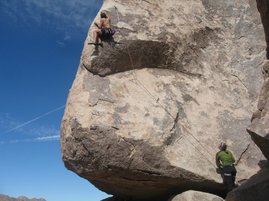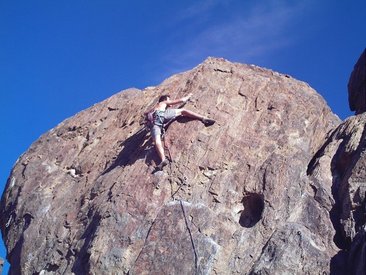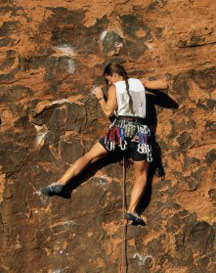Sport Leading: Basics
 Thad Houston leading on the Headstone Rock in Joshua Tree
There's a lot to lead climbing, so we've broken it up into a few sections. Be sure to read our articles on how to CLIP BOLTS ON LEAD, how to LEAD BELAY and how to SET A BOLTED ANCHOR. Here, we'll delve into some of the basic premises of getting on the "sharp end."
It is crucial that you receive professional instruction on how to lead. Do not use this guide as your only form of instruction! |
At a Glance
|
How the Sport Protection System Works

Rob leading out on Espresso, 5.10c, New Jack City, CA.
When you are lead climbing, you leave the ground with no protection in the rock. As you ascend your route, you clip quickdraws into the bolts that follow the line of the route and then clip the rope into the quickdraws. The rope is secured to you on your harness, and is also running through your partner's belay device on the ground. In the event of a fall, your partner will arrest the rope in the belay device and you will fall two times the length of the rope between you and the closest clip below you then the amount that the rope stretches.
Actually making clips requires a bit of technical understanding. We cover the important techniques to master in order to make clips safely in the section titled Clipping Bolts on Lead. Be sure to read this and watch the video to get a good understanding of how to make safe clips, and then go and learn from an instructor in person. It is also imperative to learn to belay for lead climbing. Belaying for a climber who is on lead is quite different from top rope belaying. Read our section onLead Belay and again, learn from an instructor in person.
Look at Rob in the picture above. If he were to fall before making the last clip, he would fall the length of the rope between the knot in his harness and the last bolt, and then that distance again as the rope pivots on the quickdraw below, and then a little extra as his weight falls on the rope and it stretches. That's would be a pretty big fall. If he were to take a similar fall on a lower clip, he could have hit the ground (instead he sent that sucker).
Actually making clips requires a bit of technical understanding. We cover the important techniques to master in order to make clips safely in the section titled Clipping Bolts on Lead. Be sure to read this and watch the video to get a good understanding of how to make safe clips, and then go and learn from an instructor in person. It is also imperative to learn to belay for lead climbing. Belaying for a climber who is on lead is quite different from top rope belaying. Read our section onLead Belay and again, learn from an instructor in person.
Look at Rob in the picture above. If he were to fall before making the last clip, he would fall the length of the rope between the knot in his harness and the last bolt, and then that distance again as the rope pivots on the quickdraw below, and then a little extra as his weight falls on the rope and it stretches. That's would be a pretty big fall. If he were to take a similar fall on a lower clip, he could have hit the ground (instead he sent that sucker).
Performing the Climb

Lead climbing is more difficult than top roping not only because of the increased danger and fear, but also because you need more physical stamina to complete the route. As opposed to climbing on toprope, you have to maintain certain stances long enough to reach down to your harness, grab a quick draw, clip it into the bolt, and then reach down to grab the rope and clip it through the quickdraw. This whole process leaves you hanging on one arm for an extended period of time and will spend precious energy very quickly. Finding a stance that is secure and does not require a lot of energy before making the clip is very important and can take some creativity. Use good form and remember to "hang smart" with your arms straight (on your skeleton) rather than hanging with your arms bent (on your muscles). See Basic Moves.
Fear is another challenge that most climbers must face when lead climbing. Inevitably, you will find yourself on a sport route above your last clip struggling to make the next move. You look down and see your last bolt far below. A fall from a point like this is going to be a big whipper. You see a few big rocks jutting out from the wall and imagine falling onto these and splitting your head open or breaking your leg. Panic is setting in. While fear and panic are healthy responses to this type of situation, knowing how to master them is the key to unlocking sport climbing. At this point, down climbing might be your best option if you truly cannot perform the move and a fall would be risking injury or death. This is when you must know your ability level, your limits, and the risks you are willing to take as a climber. Only you can make the decision to continue onward or to downclimb.
Fear is a powerful companion, and knowing how to master it, rather than letting it master you, is the true challenge of climbing on lead. Even though a move may be completely within your ability range, the fear that seizes you can make the move nearly impossible. If you let it, your fear can even cause you to shake and will greatly compromise your physical ability to perform. Again, you MUST KNOW YOUR LIMITS. Only you can decide to pull a risky move and only you can take responsibility for the consequences. Asses your situation, but do not dwell on the horror of falling. Understand the risk, but do not let panic take over your mind and body. Take a few deep, powerful breaths and imagine your blood vessels absorbing the oxygen from your lungs and circulating it to your pumped, tired limbs. If you can, shake out your arms and get some more chalk on your fingers. Close your eyes and visualize yourself making the next move - do NOT visualize yourself falling. Visualize the move and how it transitions into the following move. Clear your mind and focus on the hand and foot holds. Concentrate on moving upwards and translate your fear into solid, secure body placements. Focus on the balance and fluidity of your movement, on how your body is interacting with the rock. The rock is pushing you one way; how do you position your hips to properly adjust? Focus on the muscle groups that you are engaging; how can your more efficiently use them in order to reach that next hold or maintain your grip on that crimper? Focus your energy upward and toward the next clip. Pushing through the fear and panic is perhaps the most challenging aspect of climbing lead. Is is also the most beautiful.
Fear is another challenge that most climbers must face when lead climbing. Inevitably, you will find yourself on a sport route above your last clip struggling to make the next move. You look down and see your last bolt far below. A fall from a point like this is going to be a big whipper. You see a few big rocks jutting out from the wall and imagine falling onto these and splitting your head open or breaking your leg. Panic is setting in. While fear and panic are healthy responses to this type of situation, knowing how to master them is the key to unlocking sport climbing. At this point, down climbing might be your best option if you truly cannot perform the move and a fall would be risking injury or death. This is when you must know your ability level, your limits, and the risks you are willing to take as a climber. Only you can make the decision to continue onward or to downclimb.
Fear is a powerful companion, and knowing how to master it, rather than letting it master you, is the true challenge of climbing on lead. Even though a move may be completely within your ability range, the fear that seizes you can make the move nearly impossible. If you let it, your fear can even cause you to shake and will greatly compromise your physical ability to perform. Again, you MUST KNOW YOUR LIMITS. Only you can decide to pull a risky move and only you can take responsibility for the consequences. Asses your situation, but do not dwell on the horror of falling. Understand the risk, but do not let panic take over your mind and body. Take a few deep, powerful breaths and imagine your blood vessels absorbing the oxygen from your lungs and circulating it to your pumped, tired limbs. If you can, shake out your arms and get some more chalk on your fingers. Close your eyes and visualize yourself making the next move - do NOT visualize yourself falling. Visualize the move and how it transitions into the following move. Clear your mind and focus on the hand and foot holds. Concentrate on moving upwards and translate your fear into solid, secure body placements. Focus on the balance and fluidity of your movement, on how your body is interacting with the rock. The rock is pushing you one way; how do you position your hips to properly adjust? Focus on the muscle groups that you are engaging; how can your more efficiently use them in order to reach that next hold or maintain your grip on that crimper? Focus your energy upward and toward the next clip. Pushing through the fear and panic is perhaps the most challenging aspect of climbing lead. Is is also the most beautiful.
Responsibility
We highly recommend learning from an instructor either in your local climbing gym or out on the rock. Learning from your experienced friend is OK, but a professional instructor will be able to critique you without compromising any friendly relations and will most likely have important safety tips that your friend may not mention. Leading IS dangerous, and when you take to the sharp-end, you are agreeing to a certain amount of risk. Take responsibility for your climbing, your safety, and your life. Know how to use the gear, make sure your climbing partner knows how to use it, and know how to lead safely. It is YOUR responsibility as a climber to use gear appropriately and to assess the quality and safety of the bolts. If you clip a bolt that is rusty and spinning, don't expect it to hold when you take a big whipper off of it, and don't go suing the climber who placed the bolt there. It was your responsibility to check the integrity of the bolt, and use it (or not) according to your assessment. It is not the bolter's responsibility to come back and replace bolts every couple of years. Bolting is time-consuming and expensive. Those who bolt routes are performing a generous task for the climbing community.
